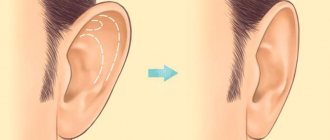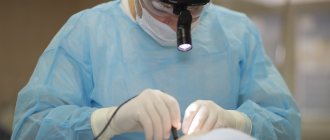Otoplasty is a surgery designed to correct problems related to the shape, position, or other features of the ears.
It is often recommended in childhood, after the formation of cartilage - optimally at 5-6 years.
This age is named for a reason: this is precisely the period that falls on the first year of school or the last year in a preschool institution.
In case of obvious problems, timely surgery will allow the baby to feel the same as everyone else.
Obvious defects in appearance, if not corrected before this point, can cause the development of complexes. If parents have the opportunity to perform surgery on their child in preschool age, this should definitely be done. Adults can apply for the procedure at any time.
Otoplasty price*
| Correction of protruding ears | from 25 000 |
| Correction of the “folding” ear | from 35 000 |
| Reduction of the auricle | from 25 000 |
| Earlobe reduction | from 25 000 |
| Earlobe reconstruction | from 26 000 |
| Reconstruction of the auricle | from 40 000 |
* the final price is determined after the initial inspection see price list
When is otoplasty indicated for patients?
The main problem with which people consult a doctor is severe protruding ears. In addition, the following may be reasons for surgery:
- Irregular ear shape.
- Smoothness of the anterior surface of the ear.
- Large distance between the back of the head and the back of the ear.
- Significant damage or absence of a normal ear.
The latter case may be associated with congenital anomalies or with the consequences of various types of injuries. Most often, this situation is solved with the help of a special silicone prosthesis.
If the patient believes that for some reason his ears do not look as they should, it is necessary to come for a consultation with a specialist. The doctor will conduct a diagnosis and tell you exactly what procedures are necessary in a particular case.
Types of otoplasty
Aesthetic plastic surgery of the ears involves the elimination of various cosmetic defects - too large the size of the ears, their asymmetry, protruding ears and pointed outlines instead of smooth contours. At the same time, the most common reason that forces people to resort to ear surgery is protruding ears. The deformity can affect both or one ear. The type and degree of protruding ears is extremely varied, so various medical tactics are used to correct this defect.
It is believed that normally the auricle and head should form an angle of 30°, while the distance between the bones of the skull and the edge of the ear should be about two centimeters, and the line of the auricle should be strictly parallel to the cheek. The very outline of the relief of the auricle is individual and unique.
Several reasons leading to this cosmetic defect:
- underdevelopment of the antihelix of the lower leg. With partial underdevelopment of the antihelix, only part of the auricle protrudes; if it is completely absent, the entire auricle protrudes;
- excessive development of the cartilaginous structure of the auricle leads to hypertrophy, to excessive protrusion of the auricle;
- protrusion of the lobe due to hypertrophy of the auricle or due to the unusual shape of the tail of the helix with otherwise normal development of the auricle;
- severe enlargement of the auricle, imbalance relative to the face. This enlargement of the ears may occur due to a vascular abnormality or after a history of neurofibromatosis.
Such aesthetic defects, especially in childhood, can cause a lot of trouble of a psychological nature, which is why they resort to otoplasty.
Reconstructive plastic surgery
may be required in the case of congenital ear defects, to restore a lost ear or part of it.
Among such anomalies the following defects can be distinguished:
- microtia of the auricle
is a congenital pathology of the development of the ear or its absolute absence, and the absence of parts of the middle ear and the ear canal itself may be observed; - macrotia
- excessive size of the auricle, caused by anomalies in the development of the entire auricle or its individual parts, usually does not entail functional disorders; - anotia
is a rare form of microtia, externally characterized by the complete absence of the auricle or a cartilaginous tubercle without a lobe; the entrance opening of the auditory canal may also be preserved; - protruding ears
– is a congenital anatomical feature due to the fact that the ears have a protruding appearance; - deformation of the helix
– sharpening of the ear, smoothed or absent helix, protrusion on the helix; - deformation of the earlobe
is manifested in the absence, bifurcation, disproportionate increase in the lower part of the ear or its fusion with nearby tissues; - rudiments of the auricle
are a change in the shape of the auricle and the degree of development of the muscles that surround it.
Reconstructive intervention is more complex; it can be used in case of deformation or complete loss of the ears due to any trauma.
Ear plastic surgery
Publications / Ear surgery
Otoplasty ( ear plastic surgery ) is an operation to change the shape of the ears, their size, eliminate protruding ears and various defects of the ears.
Today, otoplasty performs both aesthetic and reconstructive functions and provides a highly qualified approach to the high-quality correction of structural disorders and deformations of the auricle.
Most often, the main reasons for contacting our clinic for ear surgery are client complaints about protruding or protruding ears. The latter is a congenital deformation of the auricles that forms during fetal development. , ear plastic surgery involves surgical intervention in the area of the soft and cartilaginous tissues of the auricle. In the absence of contraindications, the operation can be performed from the age of 6 years. Moreover, timely correction of the structure of the ears in childhood helps to avoid a number of psychological problems for the child in the future.
Currently, plastic clinics are equipped with modern equipment that allows plastic surgery to be performed as quickly and efficiently as possible. Often, the intervention does not even require hospitalization. The risk of complications is minimized, and recovery does not take a long period.
Otoplasty surgery is performed using local anesthesia. After anesthesia, a small incision is made behind the auricle, cartilage tissue is isolated, its excess is excised, after which a new ear shape is formed. Then a cosmetic suture and bandage are applied. After healing, the postoperative scar, as a rule, is practically invisible, its size is less than 1 cm. For several days, swelling and mild pain occur in the postoperative area.
On average, the duration of the intervention is from half an hour to an hour and does not cause any particular difficulties for a professional surgeon. Approximately on the 10th day, the stitches and bandage are removed; if all the doctor’s recommendations are followed conscientiously, the rehabilitation period is quite comfortable.
In addition to protruding ears, otoplasty can eliminate other disorders and defects in the structure of the ears. Sometimes plastic surgery of one ear, or just the earlobes, is necessary. In any case, modern plastic surgery has accumulated vast experience in correcting all kinds of non-standard cases, up to the formation of a new ear with its partial or complete absence.
The price for this type of operation, such as ear plastic , is quite affordable. The cost of ear plastic surgery is significantly lower than other plastic surgeries, due to the high demand for this operation. Also, ear plastic surgery currently has a significantly low price due to the use of modern high-tech equipment, which facilitates the operation.
Rehabilitation
In the first days after otoplasty, postoperative swelling occurs in the area of the surgical wound; slight pain may be observed, which can be relieved with conventional painkillers. After otoplasty, dressings are performed approximately once every 2-3 days. Sutures after otoplasty are removed within 8-10 days. Scars after ear otoplasty are not visible because they run along the back surface of the auricle. During recovery after ear surgery, general recommendations should be followed.
- restriction of physical activity until the 1st month;
- avoid visiting saunas, steam baths and solariums;
- avoid hypothermia and direct sunlight;
- do not use glasses for two months;
- Women should refrain from wearing jewelry.
It takes about six months to fully recover after otoplasty.
Plastic surgery
Is protruding ears normal?
If you ask a person to describe his friend, he is unlikely to start with the ears.
Indeed, the ears are not the most noticeable part of the face. But only on condition that they are not conspicuous. If the ears are very protruding, then the word “lop-eared” will most likely be used in the description. After all, those around you immediately notice any deviation from the norm. Prominent ears , despite the fact that it does not affect hearing, creates significant inconvenience. The first problems are usually encountered in childhood - protruding ears greatly attract attention and can become an object of ridicule. With age comes other troubles. Girls and women with protruding ears are very limited in the choice of hairstyles, and it is not easy for men to hide protruding ears, especially if their profession requires a short haircut. Fortunately, protruding ears are a fairly easily removable obstacle to the desired appearance. For this purpose, in modern plastic surgery there is an operation called otoplasty.
Surgery and recovery
There are many otoplasty methods; their choice depends on the individual structure of the auricle. If the method is chosen correctly, then after surgery the ears do not look protruding and take on a shape that will never suggest that something was done to them. Simply put, high-quality modern otoplasty does not have any negative aesthetic and functional consequences, does not affect hearing, and the ears look normal, without attracting attention.
Ear plastic surgery is a virtually painless operation, performed under local or combined anesthesia, and the only unpleasant sensation can be noted is an injection into the skin of the auricle. Immediately after the operation, the patient can leave the clinic, appearing only for dressing changes (on average 3 times in the next week or two). The fixing bandage, which is applied after the operation, can be easily hidden with a headdress, scarf or hood. You usually have to wear it for no more than 5 days.
After just 2 weeks, when the swelling subsides and the bruises disappear, you can do hairstyles that reveal your ears.
Correction of protruding ears in medical practice
that otoplasty is one of the most popular plastic surgeries. Prominent ears are a widespread aesthetic defect, which, according to statistics, occurs in half of all babies born. Otoplasty, despite its low morbidity, low cost and short rehabilitation period, demonstrates impressive results. Patients usually note that the overall perception of the face changes for the better, complexes in children disappear, and the possibilities for choosing hairstyles and hats in adults significantly expand. In medical terms, a problem that has haunted a person since childhood is solved painlessly and easily.
Otoplasty for children - the right age
Otoplasty is a plastic surgery to correct the ears. Many parents decide to take their children to a plastic surgeon at the age of 5-6 years in order to prevent the child from developing deep complexes from worries about their ears. Other parents decide to wait until their child is of an age they feel is appropriate to be involved in the decision regarding surgery. In this case, the parents' position is usually as follows: the child does not show noticeable concern or distress about his appearance, from the outside he is well adapted socially, and, therefore, there is no need for early surgical intervention.
Photo published by Said Yusupov (@dr_usupov) Aug 22, 2016 at 5:09 PDT
This is a very subtle and complex psychological moment - it is very easy to be deceived and “miss” the problem. The child may withdraw and not show his feelings, be ashamed and afraid of wanting to change something in his appearance. You may have to be firm and persistent for the well-being of your child. Of course, we all love our children endlessly, but it is important to understand that by simply talking about how unusual ears are “just a feature” and “you are already beautiful,” we may be doing children a disservice.
I and most of my fellow surgeons firmly believe that otoplasty for children should be performed in preschool age whenever possible. Based on my more than 20 years of experience, surgery at an early age will help avoid deep psychological problems associated with self-esteem and relationships with peers.
Surgery and recovery
Preparation for otoplasty is standard: visiting a doctor, taking tests, following simple recommendations. The operation lasts on average one to two hours, depending on the complexity of the situation. If a longer intervention is planned, the surgeon will definitely warn the patient. Anesthesia can be general or local; general anesthesia is mainly used for children.
After otoplasty, the ears may hurt for 1-2 days, but the pain is not acute, so it will not cause any particular trouble. The patient will need to wear a special support bandage for about a week. Then for about another month the bandage is worn only at night. If you follow all the rules, the rehabilitation process will be quite simple. The main task of the patient is to give the ears rest for recovery.
The result of the operation is beautiful ears with the correct parameters, without stitches, scars or other signs of surgical intervention.
When will the doctor not undertake the operation?
As in any other case, there are a number of contraindications. These include:
- all diseases that impair the ability of blood to clot properly;
- inflammatory processes in the ear area or in the body in general;
- period of bearing a child, lactation;
- oncological diseases;
- acute infections;
- severe diabetes;
- age up to five years.
There are also points that are controversial. The decision on admission is made by the doctor, so the operation is preceded by a thorough examination.
Otoplasty helps to get rid of psychological complexes and obvious ear defects. The capabilities of surgeons today are quite large - they can solve almost any problem in this area.










